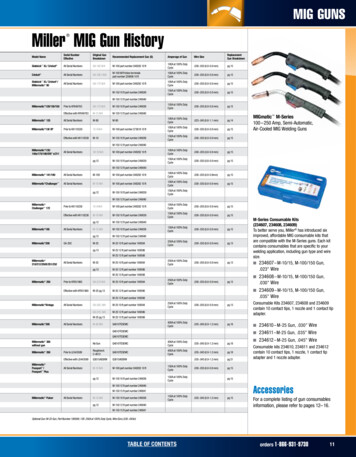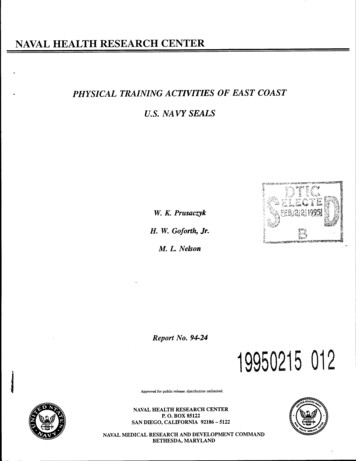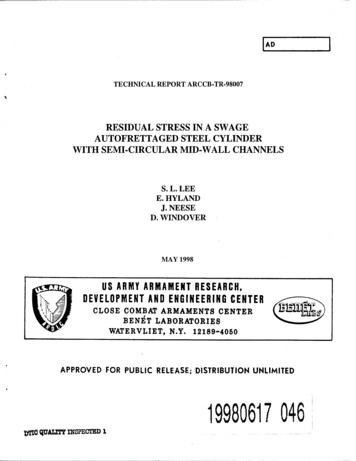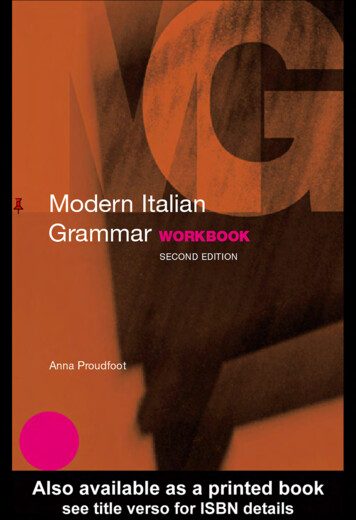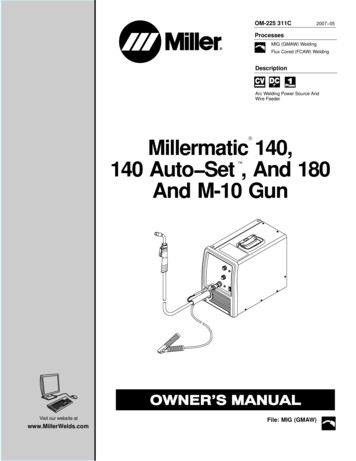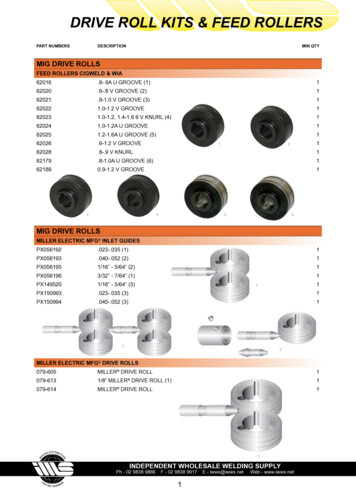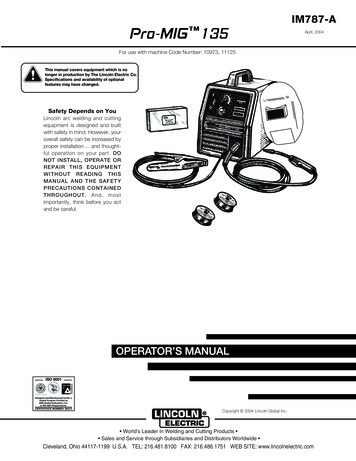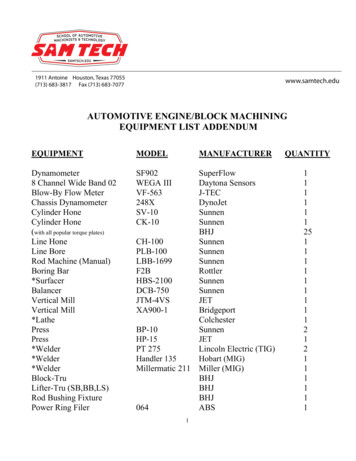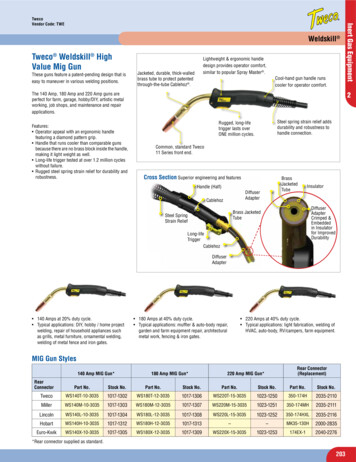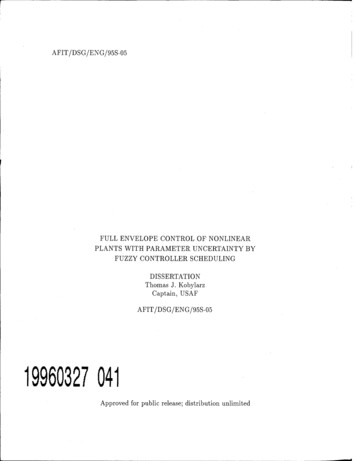
Transcription
AFIT/DSG/ENG/95S-05FULL ENVELOPE CONTROL OF NONLINEARPLANTS WITH PARAMETER UNCERTAINTY BYFUZZY CONTROLLER SCHEDULINGDISSERTATIONThomas J. KobylarzCaptain, USAFAFIT/DSG/ENG/95S-0519960327 041Approved for public release; distribution unlimited
DISCLAIMER NOTICETfflSDOCUMENTISBESTQUALITY AVAILABLE. THE COPYFURNISHED TO DTIC CONTAINEDA SIGNIFICANT NUMBERPAGESWHICHREPRODUCEDOLEGIBLY.OFNOT
The views expressed in this dissertation are those of the author and do not reflectthe official policy or position of the Department of Defense or the U. S. Government.
AFIT/DSG/ENG/95S-05FULL ENVELOPE CONTROL OF NONLINEAR PLANTS WITHPARAMETER UNCERTAINTY BY FUZZYCONTROLLER SCHEDULINGDISSERTATIONPresented to the Faculty of the Graduate School of Engineeringof the Air Force Institute of TechnologyAir UniversityIn Partial Fulfillment of theRequirements for the Degree ofDoctor of PhilosophyThomas J. Kobylarz, BSEE, MSEECaptain, USAFSeptember, 1995Approved for public release; distribution unlimited
AFIT/DSG/ENG/95S-05FULL ENVELOPE CONTROL OF NONLINEAR PLANTS WITHPARAMETER UNCERTAINTY BY FUZZYCONTROLLER SCHEDULINGThomas J. Kobylarz, BSEE, MSEECaptain, USAFApproved: c. Iqc fe/Z9 4i*f /ffSMeir Pachter, ChairmanConstantine H. HoupisSteven K. RogersA v wMatthew Kabrisky, Dean's RepresentativeAccepted:Robert A. Calico, JrDean, Graduate School of Engineering
AcknowledgementsI would like to thank all my professors at AFIT for providing me with thefoundations for completing this dissertation, especially my research committee. Theendless reviews of Dr Meir Pachter and Dr Constaintine Houpis ensured meaningfuland objective results. My thanks also goes out to all the other faculty and staff whoin some way contributed to the completion of this document.Never ending thanks goes out to my beautiful wife Korina for forcing me tosit down and complete this work, as well as taking care of the family in my absence.Of course, I can't leave out the kids; thanks Zac, Jake and Karlie for adding a littlespice to life. Now we can finally spend more time together. To all the guys on theHockey team, thanks for letting me take out my frustration.Finally to my officemates, past and present, thanks for the help and ears.Thomas J. Kobylarzm
Table of ContentsPageAcknowledgementsiiiNotationviiiList of FiguresxList of TablesxvList of SymbolsxviList of .1Motivation1-11.2Research Direction1-31.3Control System Description1-51.4Research Scope and Assumptions1-71.5Current Literature1-81.6Organization1-14Multivariate Fuzzy Logic2-12.1Fuzzy Sets and Membership Functions2-12.2Fuzzy Rules2-62.3Fuzzy Set Operations2-72.4More Fuzzy Logic2-142.4.1Conflict Resolution2-152.4.2Defuzziflcation2-19iv
PageIII.The ra-Dimensional Scheduler3.1Location of Point Controllers3-33.2Nearest Neighbor in n-Dimensions3-63.3Development of the Constraint Functional3-83.4Selection of Membership Function Variance Parameters3.4.13.53.6IV.3-12-Dimensional Variance Solution.2-Dimensional Scheduler Example3-123-163-213.5.1Plant and Point Controllers3-213.5.2The Fuzzy Scheduler3-233.5.3Optimization3-253.5.4Solution. .3-26Summary3-291-Dimensional Scheduling Examples4-14.1Simplifications Due to 1-Dimensional Scheduling4.2Variation on the Constraint Functional4-44.3Optimization4-4Set Up4-54.3.2Solution4-6Simulation Results4.5LTI and LTV Results4.74-24.3.14.44.6. . .4-74-114.5.1Solution for the LTV System4-124.5.2Solution for the LTI System4-13C-135 Aircraft Example4-184.6.1The Aircraft Model4-184.6.2Problem Statement4-214.6.3Controller Design4-22Summary4-27
PageV.Conclusions and 35.3Recommendations for Further Study5-45.4Summary5-6Appendix A.Fuzzy Identification. . .5-1. . .A-lFuzzy Logic ID ParadigmA-2A.2 Identification Concept . .A-3A.3 PolynomialsA-3A.4 XOR Gate Plant ExampleA-6A.lA.5Appendix B.Summary .A-10ExperimentsB-lB.lNonlinear Plant FormulationB.2Two State Nonlinear ExampleB-4B.3Fuzzy Logic Control of a Family of Two PlantsB-6B.4Appendix C.B-lB.3.1Linear Time-Invariant PlantB-7B.3.2Linear Time-Varying PlantB-14B.3.3Nonlinear PlantB-17SummaryB-20Support Data for Chapter IIIC-lC.lListing of MATLAB Function voronoi .mC-lC.2Listing of MATLAB Function delaunay.mC-5C.3Listing of MATLAB Function triangle .mC-8C.4Listing of MATLAB Function incircle.mC-10C.5Listing of MATLAB Function ccw.m . . .C-llC.6Listing of MATLAB Function conJmll .mC-12VI
PageC.7Listing of MATLAB Function sortjid.m . .C-15C.8Listing of MATLAB Function fom nl.mC-16C.9Listing of MATLAB Function fuz cost.mC-20CIO Listing of MATLAB Function find 2dv.mC-23C.ll Listing of MATLAB Function crosjnem.mC-27Appendix D.Support Data for Chapter IVD-lD.lIncrease in Cover by Scheduler: Nonlinear System . . .D-lD.2Constraint Surface Plots of Point Controllers: NonlinearSystemD.3D-6Constraint Surface Plots of Scheduler: Nonlinear SystemD.4 Increase in Cover by Scheduler: LTV SystemD.5D.6D-12D-18Constraint Surface Plots of Point Controllers: LTV SystemD-20Constraint Surface Plots of Scheduler: LTV System . .D-23BibliographyBIB-1VitaVITA-1vn
NotationSealars, Vectors, MatricesSealars. Denoted by upper or lower case letters in italic type.Vectors. Denoted by lower case letters in italic type, vector or scalar is takenfrom context. The n-dimensional vector x is made up of components Xi for i l,.,n.Matrices. Denoted by upper case letters in boldface type, as the matrix A,made up of elements A (?th row, jth column).Superscripts(.)Ttranspose (matrix)inverse (matrix or transform)optimal solution, complex conjugate, or complement (set)(0differeniation with respect to timeOperatorsFunctions and mappings are set in an italic font.Matrix and Vector RelationshipsA BA - B is positive definiteA BA - B is positive semidefinitex acomponent wise, x\ a%, xi a2,., xn anvm
Sets A blackboard font denotes Algebraic Fields and Linear Spaces. A calligraphic font denotes Fuzzy Sets and Fuzzy Rules. A sans serif font denotes classical sets.all of which will be upper case, some examples are:All real numbers{r e R \r 0}{r R r 0}NAll natural numbersCAll complex numbersMA Fuzzy SetHiThe ith Fuzzy RuleAA [a, b] C R where a b; a, b GIX
List of FiguresFigurePage1.1.Functional Diagram of Adaptive Controller Using Fuzzy Scheduling1-62.1.Gaussian Membership Function for Varying a2-42.2.Surface Plots of Bivariate Fuzzy Logical Injunction Operators . .2-92.3.Surface Plots of Fuzzy Logical NOT Injunction Operator.2-112.4.Fuzzy Variables "x is Negative", ux is Zero", and "a; is Positive"2-162.5.Fuzzified Mapping of Continuous Nonlinear Elements2-172.6.Fuzzified Mapping of Discontinuous Nonlinear Elements2-183.1.Generalized Neighbors3-83.2.Acceptable Thumb Print Specification and Example Responses .3-93.3.Implications of Selection of e on Normalized Weights3-153.4.Membership Function Selection of Points in R23-203.5.Block Diagram of Fuzzy Scheduler3-233.6.Nonlinear Plant with Parameter Uncertainty3-233.7.Bank of 10 Point Designs3-243.8.Increase in Object Function3-273.9.Tracking Response of Slewing Commands3-273.10. Stability Analysis4.1.3-28SIMULINK Block Diagram of 10 Point Scheduler with Normalized Weights4-24.2.Normalization of the Weights4-24.3.Bank of 10 Point Controllers4-34.4.Results of Optimization4-64.5.Gauging the Strength of a Nonlinearity4-8
FigurePage4.6.Stability Analysis of the Scheduler4-84.7.Increase in Cover4-104.8.Performance Surface Before and After Scheduling4-104.9.Constraint Surface for pio where UQ 1.2094-114.10. Visualization of Mean Normalized Output Error4-114.11. Results of Optimization of the LTV System4-124.12. Stability Analysis of the Scheduler for the LTV System4-134.13. Performance of the LTV System4-144.14. Results of Optimization of the LTI System4-154.15. Evaluation of Routhian Constraints4-174.16. Increase of Cover of the LTI System4-184.17. Classical Flight Controller by Loop Closure4-234.18. Equivalent Form of Point Controller4-234.19. Fuzzy Scheduler for C-1354-244.20. Blending of Control Inputs4-254.21. Controllers' Performance at Flight Condition #14-254.22. Scheduling Surface4-26A.l. Triangular Fuzzy Variables for Input/OutputA-4A.2. Fuzzy Fit of PolynomialsA-5A.3. Fuzzy Blending as a Function of OverlapA-6A.4.Gaussian Fuzzy Variables for all ChannelsA-7A.5. Identification Results: Error vs. Rule SetA-8A.6. Performance for Spanning Input/Output DataA-9B.l.Adaptive Control Structure for two Point Controller Designs. .B-8B.2.Root Locus and Closed-Loop Performance for either P\ B-9B.3.System Response using Single Fixed Controller Over Range of rB-llXI
FigurePageB.4.Block Diagram of Fuzzy SchedulerB-12B.5.Membership Functions used for vB-12B.6.Fuzzy Scheduled Controller Response Over Applicable Range of rB-13B.7.Thumb Print Response of System for r {1,1.5,2}, a {0.5,1.5}B-14B.8.Clustering of Response for r e {1,1.5,2}, a G {0.5,1.5}B-15B.9.LTV Plant with Externally Defined TB-16B.10. Simulation Diagram for LTV PlantB-17B.ll. LTV Plant Response of Fuzzy SchedulerB-18B.12. Nonlinear Plant ImplementationB-18B.13. Simulation Diagram for Nonlinear PlantB-19B.14. Nonlinear Plant Response of Fuzzy SchedulerB-19D.I. Increase in Slewing Capability from Point Design 1D-lD.2. Increase in Slewing Capability from Point Design 2D-lD.3. Increase in Slewing Capabiility from Point Design 3 .D-2D.4. Increase in Slewing Capabiility from Point Design 4 .D-2D.5. Increase in Slewing Capabiility from Point Design 5 .D-3D.6. Increase in Slewing Capabiility from Point Design 6 .D-3D.7. Increase in Slewing Capability from Point Design 7 .D-4D.8. Increase in Slewing Capability from Point Design 8 .D-4D.9. Increase in Slewing Capability from Point Design 9 .D-5D.10. Increase in Slewing Capability from Point Design 10D-5D.H. Constraint Surface for Point Controller 1D-6D.12. Constraint Surface for Point Controller 2D-6D.13. Constraint Surface for Point Controller 3D-7D.14. Constraint Surface for Point Controller 4D-7D.15. Constraint Surface for Point Controller 5D-8D.16. Constraint Surface for Point Controller 6D-8xn
FigurePageD.17. Constraint Surface for Point Controller 7D-9D.18. Constraint Surface for Point Controller 8D-9D.19. Constraint Surface for Point Controller 9D-10D.20. Constraint Surface for Point Controller 10D-10D.21. Constraint Surface of Point Controllers, C(y{t))D-llD.22. Constraint Surface of Point Controllers after Normalized OutputError CheckD-llD.23. Constraint Surface for Scheduler from Point 1D-12D.24. Constraint Surface for Scheduler from Point 2D-12D.25. Constraint Surface for Scheduler from Point 3D-13D.26. Constraint Surface for Scheduler from Point 4D-13D.27. Constraint Surface for Scheduler from Point 5D-14D.28. Constraint Surface for Scheduler from Point 6D-14D.29. Constraint Surface for Scheduler from Point 7D-15D.30. Constraint Surface for Scheduler from Point 8D-15D.31. Constraint Surface for Scheduler from Point 9D-16D.32. Constraint Surface for Scheduler from Point 10D-16D.33. Constraint Surface of Scheduler, C{y(t))D-17D.34. Constraint Surface of Scheduler after Normalized Output ErrorCheck.D-17D.35. Increase in Slewing Capability from Point Design 1D-18D.36. Increase in Slewing Capability from Point Design 2D-18D.37. Increase in Slewing Capability from Point Design 3D-19D.38. Increase in Slewing Capability from Point Design 4D-19D.39. Constraint Surface for Point Controller 1D-20D.40. Constraint Surface for Point Controller 2D-20D.41. Constraint Surface for Point Controller 3D-21D.42. Constraint Surface for Point Controller 4D-21Xlll
FigurePageD.43. Constraint Surface of Point Controllers, C(y(t))D-22D.44. Constraint Surface of Point Controllers after Normalized OutputError Check.D-22D.45. Constraint Surface for Scheduler from Point 1D-23D.46. Constraint Surface for Scheduler from Point 2D-23D.47. Constraint Surface for Scheduler from Point 3D-24D.48. Constraint Surface for Scheduler from Point 4D-24D.49. Constraint Surface of Scheduler, C(y(t))D-25D.50. Constraint Surface of Scheduler after Normalized Output ErrorCheckD-25xiv
List of TablesTablePage3.1.Tracking Specifications and Weights Used3-114.1.C-135 Flight Conditions and Stability Derivatives4-21A.l. All Possible Rule Sets for 2-input 1-output Binary Device .B.l. Run Number vs. r and v(r 3t 2)xvA-7B-10
List of SymbolsSymbolPageR . . . .ixR-ixR ixNixCixTZi . . . . .ixp1-1P1-2B(p,e)1-2N .1-6m . . . t)3-4C„3-4 x0 0 (s\x)3-5Ni3-7xvi
w . . . .3-10Vi3-13L3-19L' .3-19r3-21Gi(s)3-22G* .3-26Gsch{s)4-16 j 4-18ß '4-18q4-22A .B-2BB-2CB-8LonB-8XVll
List of -4FLC .1-5LTI1-7PID 20MISO3-1SQP3-2LTV3-5TRN3-8xvin
AFIT/DSG/ENG/95S-05AbstractA full envelope controller synthesis technique is developed for multiple-inputsingle-output (MISO) nonlinear systems with structured parameter uncertainty. Thetechnique maximizes the controller's valid region of operation, while guaranteeingpre-specified transient performance. The resulting controller does not require online adaptation, estimation, prediction or model identification. Fuzzy Logic (FL)is used to smoothly schedule independently designed point controllers over the operational envelope and parameter space of the system's model. These point controllers are synthesized using techniques chosen by the designer, thus allowing anunprecedented amount of design freedom. By using established control theory forthe point controllers, the resulting nonlinear dynamic controller is able to handle thedynamics of complex systems which can not otherwise be addressed by Fuzzy LogicControl. An analytical solution for parameters describing the membership functionsallows the optimization to yield the location of point designs: both quantifying thecontroller's coverage, and eliminating the need of extensive hand tuning of theseparameters. The net result is a decrease in the number of point designs required.Geometric primitives used in the solution all have multi-dimensional interpretations(convex hull, ellipsoid, Voronoi/Delaunay diagrams) which allow for scheduling onn-dimensions, including uncertainty due to nonlinearities and parameter variation.Since many multiple-input multiple-output (MIMO) controller design techniques areaccomplished by solving several MISO problems, this work bridges the gap to fullenvelope control of MIMO nonlinear systems with parameter variation.xix
FULL ENVELOPE CONTROL OF NONLINEAR PLANTS WITHPARAMETER UNCERTAINTY BY FUZZYCONTROLLER SCHEDULING/. Introduction1.1MotivationThe vast majority of control design techniques are based upon a mathematicalmodel of the system, or "plant", that is to be controlled. These models allow theuse of analytical tools to guarantee that performance specifications will be met; butthese guarantees only hold as long as the underlying models are valid. Thus, manysystems require complex control strategies to perform their designed tasks, especiallythose control systems that are required to operate in an unstructured environment.Furthermore, dealing with the entire dynamic range of operation can bring a controldesign technique to its knees. This is where the true controller design problem lies.Varying parameters and uncertainty from sensor noise, disturbances and perhapseven failures, ensure that the model is never perfect. An example of such a problemarises in flight control, where one is dealing with the nonlinear dynamics of an aircraft, whose parameters, in addition, vary continuously over its entire flight envelope.Thus the problem is then two-fold. First, the nonlinearity/complexity of the model;and secondly, the variation, or uncertainty in the model's parameters. In conclusion:The former problem is encountered when large amplitude slewing maneuvers are attempted. The latter poses problems when operating in an unstructured environmentis required.Perhaps the most useful way of dealing with nonlinearity of the model is tolinearize it about some point, p, in its operating range; that is about a point in the1-1
parameter space, P, of the model. The parameter space P encompasses both the setof generic parameters that govern the dynamics of the plant, and variables whichdefine the operating condition in the operational envelope. If the model is "smooth",a rather unrestrictive assumption for many physical systems, the linearized equationwill accurately represent the true system in some "sufficiently small" region, or ballB(p, e), about the equilibrium point p in the parameter space. The scalar e representshow far the actual operating point can deviate from p and still be "adequately" described by the model and is determined by the strength of the pertinent nonlinearity.One now has available all the tools for linear analysis, and the solution within thisneighborhood can be obtained by a myriad of linear control synthesis techniques,i.e. LQR, QFT, etc. However, one must still deal with varying parameters over theentire operating range. Varying the model's parameters may "remove" the systemfrom within this region of model validity. The controller achieved above may yieldnevertheless acceptable performance beyond the region for which it was designed,but this must be construed as luck in a specific problem solution. In an attemptto ensure adequate performance over the entire parameter space, the designer mustadequately cover the entire space with a valid region, or regions, upon which tobase the design. Robust controllers are those which attempt to increase the volumeof such a region in the parameter space. One robust control design technique thatactually quantifies its valid design region is Quantitative Feedback Theory [8, 16].Frequently no single controller will do. A common practice is to perform several point-wise control designs, each design performed for a fixed p P, that willadequately cover the entire operational range. These point designs need not be designed for only one point, but may be robust controllers covering a specified region ofP. For instance in QFT where the region of acceptable performance in P is specified.Such robust controllers are considered to be designed around a point in P and therefore, will also be referred to as point designs. Classically, this requires overlap of theballs indicating the valid regions of the individual models. The rationale is then that1-2
for any fixed point in the parameter space, one chooses "the best" controller anduses it. In this type of approach, one must devise a means of smoothly switchingbetween controllers without inducing an objectionable response during the transition. This can be interpreted in a broad sense as "robust scheduling"; in particular"gain scheduling" is when the (not necessarily robust) controllers are of a commonparametric form and these parameters are scheduled.The heart of using multiple point designs is three fold. One must devise meansto: 1) select the locations of the point models at which point designs are generated,2) choose the best controller among those available and, 3) smoothly switch betweencontrollers. The resulting controller can work quite well in many cases, as has beenproven in flight control for years. However, the means by which the actual schedulingbetween the point designs is accomplished is mainly art and very ad hoc [34]. Allthree of these steps are "problem areas" which are over come in a systematic andquantified manner in this research.1.2Research DirectionThis research effort focuses on the judicious scheduling of individual pointdesigns (which may be robust with specified operating regions) over all of P. Theparameter space consists of the actual physical parameters and/or the system's stateabout which the linearization is performed. The proposed approach is based uponusing Fuzzy Logic (FL) to blend the individual "point" designs such that for anytrajectory in the parameter space, the system performs (controls) adequately. Theability to systematically design such a dynamic scheduler is a major contribution tothe field of controller design.Fuzzy Logic is a partial membership set theory developed by Lotfi Zadeh in themid 1960s and is basically a means of representing uncertainty in a system processwithout directly applying statistical methods [21]. Fuzzy Logic is now being used in1-3
many academic fields and in commercial endeavors, and may be directly employedto: [21, 48].1. Design a controller for crisp nonlinear or uncertain plants.2. Perform System Identification (ID) of a plant.3. Model an uncertain plant mathematically.The goal of this research is to derive and explore a technique to design fullenvelope controllers, for nonlinear plants with structured parameter uncertainty,using point-wise designs that adequately span the parameter space of the plantto be controlled. The ability to base the controller on point-wise designs allowsthe designer to use all the available tools of classical, modern and robust controltheory to aid in the solution. The term "envelope" is taken from the flight controlfield and it represents that subset of P defined by the (structural and aerodynamic)physical limitations of the airframe (plant). Where robust control's aim is to increasethe valid region in P for a fixed compensator design, adaptive or scheduled controlmodifies the controller based upon an estimate of the current operating point in P.Thus, the efforts of this research is to develop a type of adaptive controller, basedon scheduling on "fast" states.Successful development of such a technique is asignificant contribution to the field of applied adaptive control.The application of the Fuzzy Logic methodology yields a nonlinear mathematical problem. Thus, the mathematics required to analyze the problem and arrive at asolution reside in the field of nonlinear analysis and quickly become intractable. Classical analytical methods of guaranteeing the stability and performance of the controlsystem are no longer applicable. Hence, this research is somewhat exploratory andit will rely to a point on heuristics and extensive simulations. This stage of affairsis a major drawback of the investigated FLC approach.This research focuses on the following.1-4
The development of a multivariate Fuzzy Logic control paradigm. This willafford state feedback control in a fuzzy setting. Effects of switching between independent point designs as the plant traversesP. How to correctly/optimally blend independent point designs as the plant traverses P while maintaining acceptable performance. Does the ability to blend the individual designs impose any restrictions onthe point designs themselves? That is, can the point designs be accomplishedindependent of each other (highly desirable), and may any conventional controldesign technique be used to achieve each separate point design? To accomplishthis, the interaction of the control design method and the fuzzy blending ofthe point designs is investigated. Does this blending ability of the proposed technique provide any characteristicswhich relieves constraints on the underlying point designs? If so, this may allowfor simpler methods of point design controller synthesis (i.e. plant inversionbased techniques) that would be unacceptable without the addition of thefuzzy scheduling. Also, does the blending extend the valid region for which acontroller may be used. That is, will the blending allow for a decrease in thenumber of point designs that would otherwise be required to cover P. Examination of what is a sufficient cover of P. Conduct extensive testing via simulation to evaluate the performance of thefinal Fuzzy Logic Controller (FLC).1.3Control System DescriptionThis research entails blending individual point designs via Fuzzy Logic toachieve acceptable responses over the entire envelope of operation.1-5To visualize
Controller 1for point p\in Pr Controller Nfor point p oinFuzzySchedulingNonlinearPlantMfuzzifierFigure 1.1mmeasurementsFunctional Diagram of Adaptive Controller Using Fuzzy Schedulingthe concept, Figure 1.1 depicts a functional block diagram of the proposed adaptivecontrol system.A "sufficient" number of individual controllers are designed a priori, say N,such that U Li B(pi,6i) D P. The parameter et- denotes the range of applicabilityof each point design p;. Classically this requires overlap of the point controllers'valid regions such that for any p P there exists at least one point design yieldingadequate response. The vector m, m P, consists of available measurements ofparameters and states on which the model relies. This measurement is then fuzzifiedto account for the uncertainty of the unknown true parameter values. The fuzzifiedm defines M., a fuzzy set defined on the "universe of discourse" P. This representsthe uncertain point of operation in the parameter space.controllers are blended, based on M., to drive the plant.1-6Then the appropriate
1.4Research Scope and AssumptionsA technique is generated for the synthesis of the blending function of Figure 1.1for acceptable control system performance over the entire operational envelope. Embedded in this goal is a determination of what is a sufficient covering of the envelopeby point designs. This removes the requirement for conventional gain schedulingin control problems in which a single fixed controller can not perform adequately.In the development of this technique, the ability to synthesize all individual pointdesigns independently and by whatever means the control engineer prefers is maintained. This allows the greatest applicability, including techniques which requirelinear time-invariant (LTI) plant models such as output feedback, LQR or eigenvector placement.Due to the nonlinear aspects of the plant under control and the introduction offuzzy reasoning, the issues of stability, performance and steady-state errors are addressed through experimentation via simulation and compared to prespecified systemresponse requirements.Although the techniques used to design the point controllers may very wellrequire the plant model to be smooth in some region about its trim (or equilibrium)point p P, the blending technique does not have this requirement. For the fuzzyscheduling, only continuity of the plant model is assumed.The proposed design approach is applicable to both uncertainty due to plantnonlinearity, and uncertainty due to parameter variation or mis-modeling. As such,the proposed research constitutes an effort in both nonlinearity and parameter uncertainty. When insufficient point-wise designs exist to cover P, the uncertainty dueto nonlinearity is greatly increased and adequate performance can not be "designedin" by the point-wise controllers alone. Therefore, the issue of sufficient cover mustbe addressed. While heuristic arguments are employed, the proposed approach isstrongly anchored in the conventional control paradigm.1-7
1.5Current LiteratureThe majority of the FLC research and development in the existing literature,especially the dynamic/adaptive designs, represents work by people with neural network backgrounds. The adaptive properties of such work usually comes from usingadaptive networks that play a part in either the antecedent or consequent actionof the fuzzy rule set. The adaptive designs not based upon neural networks relyon an optimization criterion to change the antecedent (membership function) orconsequence (control output) of the fuzzy rules.The current adaptive work can be put into categories based upon a few discernible common roots.The techniques differ mainly based upon one's belief inthe availability of accurate analytical models describing the system to be controlled.The confidence in such models ranges from none, yielding techniques that rely onempirical input/output data using adaptive neural networks; to very strong, wherestate cell [42] approaches and dynamic programming [30] ideas are used to arriveat nonlinear controllers. In between these two extreme levels of confidence in themodel are: 1) techniques based on fuzzy identification of the system, 2) those whichbelieve the system is better modeled as a system with varying or unknown membership functions and, 3) those that optimize on the consequence of the fuzzy rule.Clarification of the above groupings is given below.The main difference between ordinary adaptive neural networks and those ofpractical use in fuzzy logic controllers is the ability to incorporate linguistic rulesgiven by a human expert [32, 44]. These controllers can also monitor the system's response to their past inputs to provide learning reinforcement as in Berenji's GARICbased controller [4, 5]. In the spirit of dynamic programming [30], fuzzy logic controllers have also been implemented in neural networks using temporal back propagation to modify the rules [18].Another class of controllers uses fuzzy identification to obtain a model of theplant to be controlled. This model is then used within the controller in different1-8
ways.One method is to use the model to predict the system's response to anoriginal fuzzy rule. This response is compared with the desired response and theconsequence of the rule is modified such that the new rule includes a correction toremove the predicted error [2, 23]. Another technique is to design a desired open loopcontroller and augment it with the "inverse model" dynamics obtained from fuzzyidentification. The inverse model then "cancels" the actual plant and the response isdictated by the open loop controller [2, 22, 23]. Lai and Lin [22] combine this fuzzyidentification method with modifying the rules' consequences via an optimizationroutine. They begin with a fixed set of membership functions to perform a fuzzy IDof the plant. The c
Never ending thanks goes out to my beautiful wife Korina for forcing me to sit down and complete this work, as well as taking care of the family in my absence. Of course, I can't leave out the kids; thanks Zac, Jake and Karlie for adding a little . 3.3 Development of the Constraint Functional 3-8 3.4 Selection of Membership Function Variance .


